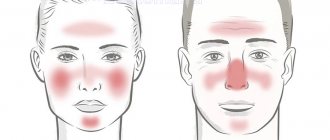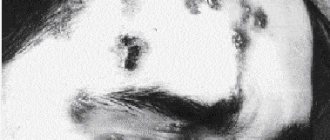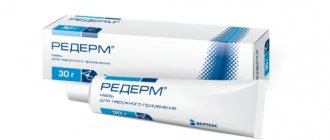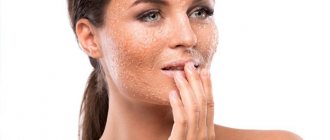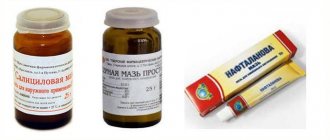Author
: Grachev Ilya Illarionovich
Editor
: Efremov Mikhail Mikhailovich
Date of publication: 08/14/2018 Date of update: 02/16/2020
The very first manifestations of psoriasis often appear on the head, then spreading throughout the body. Psoriasis on the scalp occurs with itching and the risk of bacterial complications. If you suspect the psoriatic nature of the rash, you should immediately consult a doctor - the disease is highly treatable at the very beginning. The article contains all the information about the symptoms and all known methods of treating this form of the disease.
Causes of psoriasis on the head
This is a chronic non-contagious dermatological process that develops in individuals with a hereditary predisposition. The causes of psoriasis on the scalp and the mechanism of its development are not fully understood. But it has been established that the process develops against the background of metabolic and immune disorders. The body loses control over the division of skin epithelial cells: they begin to divide much faster. Signs of keratinization also quickly appear, manifested in the form of peeling. At the same time, inflammatory processes develop in the skin.
The main cause of scalp psoriasis is a hereditary predisposition. Scientists are trying to identify the genes responsible for transmitting the disease from generation to generation. Individual altered areas related to different genes that are found in patients and their close relatives have already been identified.
But a person who has a genetic predisposition does not necessarily get sick. External and internal predisposing factors are no less important. Psoriasis of the scalp begins in genetically predisposed individuals due to exposure to the following factors:
- mechanical irritation of the skin (with a hair brush with hard teeth; injury to small wounds and crusts that appear with seborrhea, etc.);
- cold exposure;
- past infectious diseases; often after streptococcal impetigo - purulent rashes mainly on the skin of the face; develops in children and becomes the impetus for the development of an autoimmune process;
- chronic stress and high loads;
- frequent smoking, alcohol abuse;
- diet violations - irregular, unhealthy dry food, excessive consumption of high-calorie foods and spicy seasonings;
- for hormonal disorders that affect the condition of the sebaceous glands of the skin - obesity, imbalance of sex hormones, diabetes, diseases of the thyroid gland, pituitary gland, hypothalamus;
- for diseases of the liver and kidneys with impaired function of these organs; neutralization of toxins occurs in the liver, and through the kidneys they are eliminated from the body; intoxication can become a trigger point in the development of the disease.
Under the influence of one or several factors, the interaction of the organism with the environment is disrupted. Protein, fat and carbohydrate metabolism is disrupted, which causes acceleration of metabolic processes in the skin and its peeling.
Psoriasis of any localization can spread throughout the body, so do not delay treatment.
See how easily the disease can be cured in 10-12 sessions.
Changes in the immune system manifest themselves in the form of increased sensitivity of the skin to any external influences (including combing or frequent hair coloring). In response to such influences, antibodies are produced to one’s own cells, provoking the occurrence of an autoimmune inflammatory process. The reasons why inflammation begins are not yet fully understood. This is one of the priority tasks of medicine in the treatment of psoriasis.
Facial dermatitis:
To get rid of dermatitis on the face you will need a comprehensive approach. To eliminate the symptoms of a disease, it is necessary to determine the cause of its occurrence.
First of all, diagnosis is important. A dermatologist will identify the type of dermatitis, prescribe tests to find the allergen and prescribe treatment.
- A lifestyle adjustment will be required: a minimum of stress, regular sleep, sports and walks in the fresh air will have a beneficial effect on the condition of the body in general and the health of the skin in particular.
In advanced cases of chronic facial dermatitis, patients sometimes require a change in climate, place of work and place of residence. Don't let the disease get worse so you don't have to take extreme measures!
- Therapy includes a hypoallergenic diet. First of all, it is important to exclude the identified allergen product. Adjust your diet in favor of vegetables and fruits (except citrus fruits), boiled meat, fish and cereals. It is better to give up spicy, salty, sweet, smoked, and canned foods.
- Proper skin care is important. A cosmetologist-dermatologist will help you choose hypoallergenic cleansers and cosmetics individually for you.
Treatment of dermatitis on the face: ointments
- When treating allergic dermatitis, individuals are prescribed anti-inflammatory (hormonal and non-hormonal) topical agents (ointment, cream), which reduce all symptoms, and antihistamines.
- Treatment of contact dermatitis on the face begins with excluding any contact with the allergen and prescribing anti-inflammatory and healing ointments. If there has been prolonged contact with the allergen, and the disease is very advanced, it is possible to prescribe a steroid cream or ointment containing hormones. Only they can cope with serious ulcers on the face.
- For atopic dermatitis of the facial skin, anti-inflammatory drugs (hormonal and non-hormonal) are often used to relieve redness and itching.
- Seborrheic dermatitis is caused by a fungus, so it is treated with antifungal agents.
- When treating perioral facial dermatitis, the main symptoms are eliminated with antihistamine ointments; Hormonal creams are prescribed in special cases, if the cause of the disease is accurately diagnosed.
Cream “La-Cri” is an effective remedy for facial skin dermatitis
Experts recommend soothing the manifestations of dermatitis on the face with the help of La-Cri cleansing gel, enriched with life-giving extracts of licorice, violet, string and walnut, with the addition of avocado and olive oil. It gently cleanses irritated skin and helps reduce inflammation.
In addition, treatment of dermatitis involves the use of La-Cri emulsion and cream for sensitive skin, which help restore and disinfect the skin. The cream has an anti-inflammatory and regenerating effect, and the emulsion stimulates metabolism and restores the water balance of the epidermis, moisturizing and softening the skin.
Skin dermatitis on the face: folk ways to combat the disease
“Grandma’s recipes” are effective mainly for relieving symptoms of the disease. We urge you to take your health seriously and undergo treatment under the supervision of a doctor. Use natural remedies exclusively as auxiliaries and only after the doctor’s permission.
Homemade ointments
Tar: Add 6 g of tar to a regular tube of shaving cream. Heat to 600C. Use the cream 2-3 times a day.
Potato: mix 100 g of grated potatoes with 7 ml of liquid honey (if you are not allergic to it). Apply the ointment to your face and leave it overnight.
Herbal decoctions
It is recommended to store decoctions in a cool place for no more than 3 days. Use in courses: wipe the skin 2-3 times a day, course – 1 month.
Walnut: chop 6-7 walnut leaves, add 1 glass of water, boil over low heat for 5-6 minutes. Leave for 2 hours.
Hops: 10 g of hops and 10 g of string, pour 150 ml of boiling water. Leave for 40 minutes.
Oils
Oils can be used undiluted or added as an ingredient to various recipes. Oil formulations should be applied pointwise to areas affected by dermatitis 2-3 times a day.
Cypress and myrrh: add 2 drops of these essential oils to 10 g of baby hypoallergenic cream.
Geranium, cedar, mint: pour 5 drops of oil into 16 ml of milk (do not use inside!)
Essential oils of black currant, geranium, cedar, ylang-ylang, lavender, jojoba, almond, sea buckthorn, and chamomile help well in treatment.
Symptoms of psoriasis of the scalp
Psoriasis on the scalp manifests itself in the form of characteristic symptoms. The disease can begin acutely with multiple rashes (vulgar form of psoriasis) or gradually with itching and flaking of the skin, and only then characteristic rashes appear (seborrheic form). Psoriasis on the head, photo:
The more common onset is gradual, in the form of dandruff and flaking. In the early stages, these are small areas in the occipital region. Peeling spreads to larger areas and itching begins. Constant scratching of the skin contributes to its roughening and abrasions. What does psoriasis on the scalp look like? The initial symptoms of psoriasis on the head in the photo look like this:
In the area of scratches and abrasions, redness first appears, and then small inflammatory nodules and papules, surrounded by a bright rim that rises above the surface of the skin. Accompanied by severe itching, the rashes increase in size and merge with each other. Features of the rashes are:
- white “shavings” covering the papules; when scraped, it resembles a stearic speck; in the seborrheic form, the scales have a yellowish color and the phenomenon of the stearin spot is not so pronounced;
- if you scrape off all the “chips”, a smooth translucent surface is revealed;
- further scraping leads to the appearance of droplets of blood on the surface - “blood dew”.
In the photo, three signs look like this:
These three characteristic manifestations distinguish scalp psoriasis from seborrheic dermatitis, with which it is easily confused. Subsequently, the papules merge and form psoriatic plaques, which have different configurations and sometimes spread over the entire surface of the head.
The course of scalp psoriasis can be mild with the appearance of isolated rashes at the initial stage. These rashes then go through all three stages of development. In severe forms, the rashes occupy an entire significant area and spread to the face and neck in the form of a crown - an inflammatory rim covered with silvery scales. The hair roots are not affected, but the psoriatic process is often accompanied by a bacterial, fungal or mixed infection, which leads to complications that are not so easy to cure. This is what the crown looks like, photo:
Symptoms of seborrhea
With the dry version of seborrhea, most patients experience tangible signs that prompt them to consult a specialist and undergo treatment for seborrhea:
- fine dandruff;
- thinning and weakness of scalp hair;
- increased hair loss per day compared to normal;
- crusts and scratch marks on the scalp;
- itching, dry peeling, burning of the scalp.
With seborrheic dermatitis, seborrheic alopecia may develop: the hair becomes thinner, weaker and dull, begins to split, loses its healthy appearance and shine, and may fall out rapidly.
The disease does not have a systematic effect on the body, but it makes you suffer from changes in the appearance of your hair, dries out the scalp, and with serious causes of its occurrence, emotional disorders are possible.
Treatment of dry seborrhea of the scalp is always aimed at eliminating provoking factors. It is necessary to establish what disorders the patient has and draw up a treatment plan for them first. If there is a pathogenic flora on the skin, you will need special cosmetics designed for seborrhea. In any case, the doctor will recommend products with a calming and anti-inflammatory effect - special shampoos, emulsions for application to the skin.
With seborrhea, it is important to establish the correct functioning of the gastrointestinal tract, establish a healthy daily routine with sufficient sleep and rest, and minimize existing stress. In addition to treatment, it is worth paying attention to physical activity and psycho-emotional health.
Stages of psoriasis on the head
The disease lasts a long time, exacerbations are replaced by remissions. The frequency of exacerbations and the severity of symptoms depend on the presence of provoking factors.
Progressive stage
Rash and inflammation spread, accompanied by severe itching. In the initial stage, Koebner's symptom is present - the appearance of psoriatic rashes at the site of scratches and abrasions.
Stationary
The process is in the same state, not spreading, but not dying out.
Regressive
The process gradually subsides, the itching disappears, the rash turns pale, the inflammatory infiltrate decreases, gradually taking on the appearance of a spot; the color of the rash fades starting from the center, forming ring-shaped figures with a brighter border. Sometimes they begin to turn pale from the periphery to the center and then take on the appearance of whitish rings (a symptom of psoriasis on the head - Voronov's pseudoatrophy). The healing phase can take quite a long time and gradually only white depigmented spots remain on the skin.
Treatment methods for psoriasis on the scalp
Good to know
- Treatment of psoriasis on the elbows
- Treatment of psoriasis on the legs
- Treatment of psoriasis on nails
- Treatment of psoriasis on the hands
- Treatment of psoriasis on the face
- Treatment of palmoplantar psoriasis
Scalp psoriasis requires systematic treatment under the supervision of a physician. An active lifestyle, quitting smoking and alcohol, and following a diet are of decisive importance. The disease must be treated comprehensively, using methods taking into account the characteristics of the patient’s body. Complex therapy can include modern European techniques, drug treatment, as well as time-tested oriental methods. Such treatment can immediately significantly improve the patient’s condition and lead to the development of stable remission within a few weeks.
PRP therapy is a method based on the ability of platelets (red blood platelets) to secrete a growth factor that stimulates the regenerative abilities of cells. By centrifugation, the patient's blood is enriched with platelets and then precisely injected into the scalp. The technique allows you to significantly accelerate the onset of remission and prevent the development of relapses.
Autohemotherapy - treatment is carried out by intramuscular injection of a small amount of blood taken from the patient’s vein. This has a general stimulating effect and restores the epithelium of the head. After treatment, stable remission is observed.
Reflexology is the effect of various methods on special points on the body that are reflexively associated with organs and tissues. One of the most ancient and effective traditional methods of treatment. The points can be affected by acupuncture (acupuncture), moxibustion, massage, etc. Treatment of scalp psoriasis with these methods has been practiced in Eastern medicine for thousands of years. Therapeutic procedures are performed by a reflexologist.
Vacuum therapy - exposure to rarefied air on biologically active points - is one of the methods of reflexology. It can be carried out using cans or special equipment. Promotes rapid restoration of damaged tissues. As a result of the use of vacuum therapy, the affected areas are significantly reduced.
Herbal medicine - dermatologists widely use medicinal plants in their practice in the form of infusions, decoctions and ready-made pharmaceutical forms. When used correctly as part of complex treatment, they are very effective both in the initial stages of the disease and in its long-term forms. If you add herbal medicine, the effectiveness of other treatment methods increases and the risk of developing undesirable drug effects decreases.
Red spots on the skin after stress
Diagnosis of skin diseases
My face looks like an orange peel: what should I do?
When “orange peel” appears, the question is how to remove unpleasant symptoms.
Many people try to disguise them using foundation. In fact, this tactic is highly undesirable, as it can lead to clogged pores and make the problem even worse.
If the skin on your face has become like an orange peel, you need to undergo a series of restorative cosmetic procedures as soon as possible. In this case, atraumatic facial cleansing, peeling and laser exposure are most effective.
Atraumatic facial cleansing
This procedure is a combination of soft dry cleaning and mechanical action. It allows you to eliminate acne, oily shine, inflammation, and activates regeneration processes.
Atraumatic facial cleansing has many advantages:
- visible result after the first session;
- no risk of skin damage;
- the ability to treat only problem areas.
The first stage of the procedure involves sequential application of masks with glycolic acid to the skin. However, since such an effect does not eliminate all impurities, it is combined with manual peeling.
At the end of the procedure, a mask is applied to help moisturize the skin and tighten pores. In total, the session lasts about half an hour.
Peelings
Peels allow you to get rid of enlarged pores, increased oiliness or excessive dryness of the skin, inflammatory processes and many other problems.
It is no coincidence that they are one of the most popular cosmetic procedures.
There are chemical, mechanical and hardware peels. The first are based on the influence of chemicals (usually acids), the second are based on manual application of drugs with active ingredients, and the third can be carried out using a laser or ultrasound.
Depending on the degree of impact, the following types of peeling are distinguished:
- surface;
- median;
- deep.
Maximum penetration into the skin layers allows for the most pronounced effect, but is accompanied by increased skin trauma. That is why such procedures should be carried out exclusively in the salon.
Laser
The effect of the laser also allows you to quickly eliminate the effect of orange peel on the face. This procedure is in great demand because it acts against a number of cosmetic defects:
- hyperpigmentation;
- wrinkles;
- striae;
- enlarged pores;
- acne and post-acne;
- rosacea;
- scars.
A positive result is noticeable after the first visit to the clinic, but usually experts recommend at least 2-3 sessions.
At Nomosclinic, this procedure is carried out using a reliable Italian Synchro Play DEKA device equipped with a cooling system. The cosmetologist can regulate the depth of its effect, ensuring a pronounced result without unwanted side effects.
More about procedures
Jessner Peel
Laser rejuvenation
Atraumatic cleaning
Treatment of psoriasis on the head at the Paramita clinic
At the Paramita clinic in Moscow, this disease is treated by dermatologists who have training and clinical experience in treating this disease with all currently known methods. In their work, they use new Western methods of drug treatment in combination with traditional Eastern techniques, which were successfully used by doctors of Ancient China and Tibet for thousands of years.
To avoid relapses, it is necessary to eliminate the cause of the disease.
Read more about our unique method of treating psoriasis
“Paramita” is a leader in the treatment of psoriatic processes in Moscow in a variety of ways with an individual approach to each patient. Several sets of traditional methods in combination with drug treatment can permanently relieve the patient of problems with the scalp.
The effectiveness of treatment at the clinic is noted in their comments and reviews not only by patients who regularly receive maintenance treatment, but also by colleagues from other Moscow clinics.
Sign up for a free initial appointment
Clinical researches
The conducted clinical study proves the high efficiency, safety and tolerability of products for daily care of children's skin. As a result of therapy, a decrease in the activity of the inflammatory process, a decrease in dryness, itching and flaking was noted. The products will also be effective in the treatment of minor burns.
The safety of “La-Cri” is confirmed by research by scientists from the AILC of the Federal State Institution “R.R. Vreden Russian Research Institute of Traumatology and Orthopedics” and numerous government certificates.
Cream "La-Cri" for sensitive skin:
- eliminates itching and irritation;
- relieves skin redness;
- moisturizes and carefully cares for the skin;
Emulsion "La-Cri":
- moisturizes and nourishes the skin
- relieves itching and irritation
- soothes and restores skin
Cleansing gel “La-Cri”:
- gently cleanses the skin
- relieves redness and itching
- restores and nourishes the skin.
Sources:
- N.M. Sharova, Approaches to the treatment and prevention of diaper dermatitis, Medical Council journal, 2018
- G.V. Molokova, E.V. Bukina, Diaper dermatitis in children with sensitive skin, Journal of Dermatology and Allergology, 2019
- N.L. Rybkina, Modern approaches to newborn skin care: pediatrician tactics, journal Bulletin of Modern Clinical Medicine, 2014
- V.V. Chebotarev, N.V. Chebotareva, M.S. Askhakov, E.V. Bronnikova, Sensitive skin: causes, methods of therapy, journal Medical Bulletin of the North Caucasus, 2015
Photos of dermatitis
Photo album on the disease
Prevention of psoriasis on the head
Prevention of psoriasis on the scalp is especially necessary for people with a hereditary predisposition who have sick relatives. It includes eliminating the impact of the following factors:
- any prolonged exposure to the skin;
- poor nutrition and sedentary lifestyle;
- prolonged stress and heavy loads;
- smoking and alcohol abuse;
- hormonal disorders - if you suspect such disorders, you should immediately contact an endocrinologist;
- intoxications - promptly treat all chronic diseases that contribute to metabolic and immune disorders.
A dermatologist after an examination can tell you how to cure psoriasis on the scalp. Therefore, you should not delay consulting a specialist, because the initial stages of the disease are much easier to treat. Can this process be cured? It is impossible to cure the disease completely, but if a person is treated regularly, there is a great chance of getting rid of relapses for a long time.
Facial dermatitis: causes
Statistics say that today every 8th person in the world suffers from facial dermatitis in one form or another, and adults and children suffer equally. And half a century ago, this disease occurred exclusively in children, and quite rarely. What changed?
It is not known exactly what exactly provokes the development of the disease: each case is individual. The main risk factors include heredity and poor lifestyle.
If you have a weakened immune system due to illness, you smoke, experience stress, do not take enough care of your facial skin, use low-quality cosmetics, neglect a healthy diet and vitamins, then sooner or later all this can affect your health and lead to dermatitis on the face.
Diet for scalp psoriasis?
There is no special diet, but treatment of psoriasis of the scalp involves proper 4 meals a day containing all the ingredients necessary for the body. Products that irritate the skin should not be present on the table:
- spicy, salty, sour;
- fruits rich in essential oils (fresh garlic and onions, radishes);
- fried, smoked, canned foods;
- caffeine-containing drinks – strong tea, coffee, Coca-Cola, etc.;
- alcoholic drinks – they contribute to the development of relapses of the disease.
It has been established that meat foods provoke an exacerbation, so the diet should contain more foods containing complex carbohydrates, lean meat, cottage cheese, yogurt, etc.
Drug therapy for scalp psoriasis?
Medicines are selected according to the patient’s condition and the presence of certain symptoms of the disease. In the initial stage of psoriasis on the scalp, the following external remedies are used:
- when weeping, solutions and creams are prescribed that eliminate these symptoms and prevent bacterial and fungal infections; Picladol, Psorilom, Zinocap creams are suitable; Belosalik is prescribed from solutions; apply the medicine to the affected skin areas every day;
- if the skin is dry, then it is treated with ointments; ointment with salicylic acid - has a softening effect; ointments with tar have the same effect; Ointments with zinc and Daivonex ointment (an analogue of vitamin D3 + glucocorticoid betamethasone - help quickly eliminate the symptoms of psoriasis);
- ointments and creams with corticosteroid hormones are prescribed for the treatment of common forms of psoriasis on the scalp;
- Shampoos are widely used; Thus, tar shampoos (Psorilom, Friederm Tar, etc.) relieve inflammation and soften crusts; shampoo with zinc has an antiseptic and softening effect, relieves inflammation; shampoos are used for a long time.


